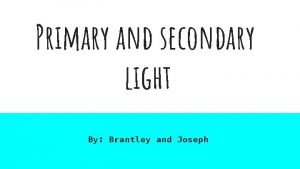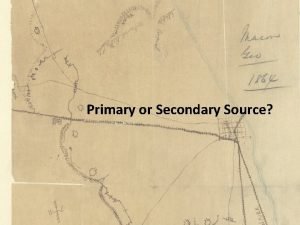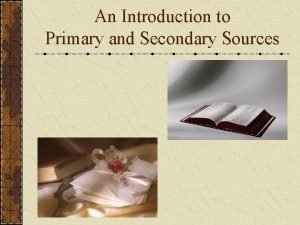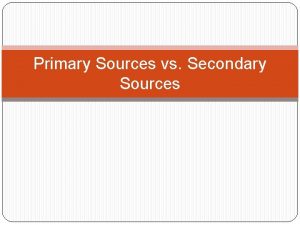Primary and Secondary Sources Notes and Examples Primary












- Slides: 12

Primary and Secondary Sources Notes and Examples

Primary Sources • primary source- a document or object which was written or created during the time a particular event occurred – provides an inside or firsthand view of a particular event or time period – typically only includes one point-of-view – often rare, one-of-a-kind – examples- diary entries, speeches, government records, autobiographies, poetry, newspaper articles, furniture, clothing

Secondary Sources • secondary source- source that was created ` after an event or time period and interprets or analyzes primary sources – can (but not always) provide a more fair account of the event because it can include more than one point of view, or may include information that was unavailable at the time of the event – usually has many copies – examples- textbooks, biographies, magazine articles, encyclopedias

Determining the Type of Source • look for dates, materials used, and other clues to help determine whether the source is primary or secondary • some sources, such as magazine articles, paintings, poems, etc. , can be either primary or secondary sources depending on when they were created – primary source- a magazine article that reports the details of a recent event – secondary source- a magazine article written long after an event that uses a variety of sources to analyze/interpret the event

Primary or Secondary? You decide!

Washington Crossing the Delaware Artist- Emanuel Leutze, 1851


The Emancipation Proclamation, 1863

Mount Rushmore, 1941

Australopithecus Skeleton “Lucy” • discovered in 1974 • estimated age- 3. 2 million years


Plane Wreckage from 9/11/01 Attacks Found wedged between two buildings in April 2013
 Primary secondary tertiary
Primary secondary tertiary Is autobiography a primary source
Is autobiography a primary source Primary and secondary source of light
Primary and secondary source of light Succession venn diagram
Succession venn diagram Primary and secondary sources of light
Primary and secondary sources of light Print sources and web sources
Print sources and web sources Importance of water management
Importance of water management Types of syndicated data
Types of syndicated data Secondary sources
Secondary sources Is an illustration a primary or secondary source
Is an illustration a primary or secondary source Secondary brand associations中文
Secondary brand associations中文 Secondary source
Secondary source The terms external secondary data and syndicated
The terms external secondary data and syndicated























